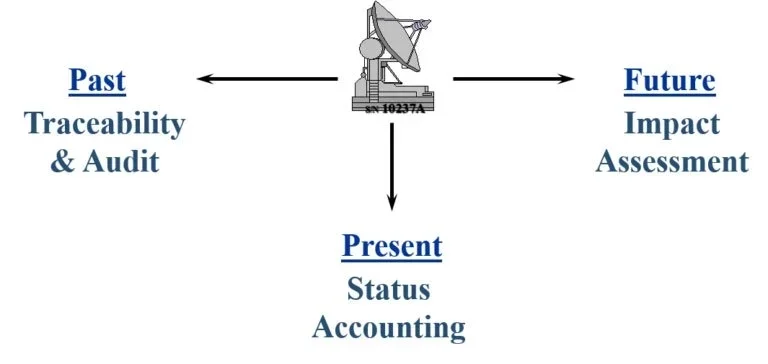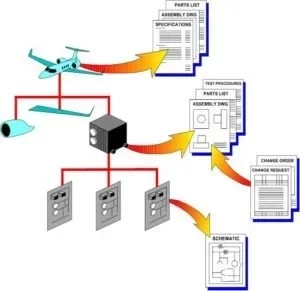PDMPlus Configuration Management Capabilities
Inside PDMPlus : Overview l Applications l Capabilities l Functionality l Features l Benefits l Resources l Demonstration
Configuration Management is the application of appropriate resources, processes, and tools to establish and maintain consistency between the product requirements, the actual product as designed or deployed, and all associated product information and documentation. Complex products and the assemblies, systems, networks, and sites which they populate require highly capable yet flexible configuration management tools to ensure proper collection, tracking, and reporting of configuration-related data throughout the entire product-use lifecycle.
Configuration management tools like PDMPlus meet these rigorous requirements by providing the essential CM capabilities for managing, documenting, and tracking each of the past, present, and future states of equipment deployed in-service in the field. These configuration management tools capabilities include:
A Central Database of Authority for Live Configuration Data
Product Structure and BOM Management
Item and Part Identification
Multiple Product Line Management
Configuration Item Management
Change Management, Change Effectivity, and Impact Assessment
Baseline Management
As-Configured Management of As-Built, As-Designed, and As-Maintained
Workflow Automation & Action Item Tracking
Document Control & Collaborative Review
Reporting of Performance, Contract, Compliance, and Regulatory Requirements
Let’s examine a number of these capabilities starting with a central database of authority for accessing live configuration data.
Configuration Database of Authority
PDMPlus provides a Configuration Database of Authority (CDA) that design authorities and manufacturers, along with their contract supply chain and aftermarket service partners, can use for secure web-based access to all product metadata, documents, and drawings in support of configuration lifecycle control, change, and review processes. The CDA vault provides many features required for managing the as-configured product structure far removed from the original engineering CAD or PDM vault.
PDMPlus maintains the CDA such that users, no matter their role or level of expertise, can access current, trusted configuration documentation and product structure data in real-time. Rules-based automation of change review, change incorporation, and task tracking processes ensures users are presented with accurate up-to-date information from the CDA at all times.
Product Structure & BOM Management
PDMPlus provides all of the essential functionality needed for effective product structure and BOM creation, management, interrogation, and maintenance in support of configuration control and reporting.
Configuration management rules embedded into PDMPlus ensure that the product data used for change analysis and execution is readily accessible, current, and accurate. Incorporating provisions for the change process at the time of BOM creation allows for automatic BOM updates upon change approval and incorporation, and provides:
Reliable easy access to all current and historical product information for status queries
Support of full accounting, impact assessment, traceability and audit functionality
Efficient part management from an in-depth search capability with real-time system updates
Visibility and control of one-to-many, many-to-one, and many-to-many data relationships
Consistent data exchanged with external applications such as CAD, PDM, SCM, ERP, and ILS
Users are not required to search across multiple systems to find current product structure information
Configuration Item Management
Configuration Items (CI) denote unique components, data, or documents related to the configuration that are designated for separate configuration management tracking. These can include items that are serialized, high-cost, long-lead, safety related, regulatory approved, certified, government funded, or other components specified by the customer or contract. CIs provide the ability to reduce the amount of detail or levels of indenture included in change analysis, configuration tracking, and report documentation.
The CI functionality intrinsic to PDMPlus supports a number of important characteristics:
CIs can be used to create document lists and collections of parts or software items.
Each product structure item or document can be related to as many CIs as desired.
CIs can have unique parent-child relationships that do not need to follow the product structure.
A CI can be created and structured before any items or documents exist, then once the items and documents are developed, they are simply added to the appropriate CI as needed.
When using CIs to track serialization, government funded equipment, or other identifying marks, usage is captured on those items within the CI module.
CI allocation allows tracking of the number of a particular item authorized to be produced or deployed under a given contract to ensure that additional unfunded resources are not used.
Change Management, Change Effectively, and Impact Assessment
The extensive change management capabilities within PDMPlus provide all the necessary information required to make intelligent decisions when evaluating product changes. PDMPlus provides as standard a set of pre-programmed yet easily customizable change objects including:
Engineering Change Request (ECR)
Engineering Change Order (ECO)
Engineering Change Proposal (Embedded ECP Form 1692)
Deviations and Waivers
Unsatisfactory Condition Report (UCR)
These objects form the basis of the closed-loop change management system, integrated to provide the part, data, and document information required for effectivity and impact analysis. Extensive process rules and data relationships ensure data integrity as changes are analyzed and executed.
Reviewers and approvers of change requests have ready access to used-on information, relationships of affected parts to other products and projects, as well as relationships to configuration items, document baselines, serialized fielded products, work-in-progress information, and digital documentation.
As-Configured Management
The As-Configured records within PDMPlus contain all the product data as the product exists – or as is desired – in the physical world. As-Configured records can be used at any point in the lifecycle of a product from the As-Designed through As-Built, As-Tested, As-Delivered, As-Maintained, and As-Retired stages. The records leverage existing product structure tree details to create a record that includes parts and parent-child relationships. The structure can then be used to aggregate:
Cross-referenced documentation at the current approved revision
Parts list details such as alternate and substitute parts, reference designators, and packaging
Certification records on any item in the structure
The As-Configured Record then provides a place for recording installed configuration details such as:
Item Serial Numbers
Item Unique Identification (IUID)
Bar Codes
Reference Designators
Software Versions
Actual Document Revisions
Installation and Certification Test Data
Task Records
Work Order Authorizations for Installation, Maintenance or Shipment
Other User-Defined Identifiers
Once the record is established, users with proper access have the freedom to manipulate the record to reflect the actual configuration of parts and assemblies used in installations or builds, especially when they stray from the original specification. Entire sub-assemblies can be removed for refurbishment and reuse within other structures while maintaining all unique serialization history.
As-Configured records are preserved even as the product design and documentation changes. This decoupling of the established configuration record enables true management of in-service fielded assets. Having this capability within the CM system provides visibility to the design and maintenance history well into the service life of the product. This enables failure tracking and more accurate impact assessment with improved risk mitigation.
Baseline Management
PDMPlus’ baseline management capability creates a snapshot in time of documentation at its latest version that maintains a basis from which to specify, assess, and process changes to a product. PDMPlus baseline records provide a numeric listing of documents at their latest revision level including outstanding approved changes related to a product or CI.
Baseline records can be used to document the traditional functional, allocated, and product baselines as a basis for configuration change. These baseline records may also be used to capture bid sets or document sets for audit purposes. Bulk download capability provides a quick way to create a set of electronic document source files to be used off line or delivered to sub-contractors to communicate design.
Document Control and Collaborative Review
Document viewing, storage, and retrieval is provided through a two-level security system. Product configuration metadata and associated cross-referenced information is easily accessed through a contract and project oriented security mechanism. Drawings and document are stored in the PDMPlus CDA vault where a second set of user credentials and permissions can be established to further enhance security. While users may have permission to view configuration metadata, they may not be allowed to view the actual document.
Document versioning is performed by putting changes through a Document Review workflow template that triggers digital routing, review, and analysis of pending changes. Prior to the document being revised, users may access work-in-process for the status of the current document revision with its unincorporated changes. PDMPlus incorporates the changes and rolls the revision. The new revision of the document is recorded and any attached files are automatically linked as a part of the incorporation procedure. All historic revisions and associated change paper remains accessible to users.
PDMPlus’ collaborative Online Document Review capability allows all participants in the change process to participate in the review process regardless of their geographical location, thus facilitating online change control boards (CCBs). The ability for the supply chain to simultaneously participate in the review process and access all the needed information reduces change processing time, the cost of changes and the actual number of changes.
Workflow Automation
As new items, documents, and changes are added to the product data, reviews are constantly being performed to verify components for suitability, accuracy, completeness and conformance to requirements. Changes to design details, product documentation, or service orders must go through these checks prior to incorporation. Any change to product data should be vetted by a process that is appropriate to the complexity and impact of the change. Automation of these review processes is vital to the efficient management of product information and change.
Standard functionality in PDMPlus includes workflow automation that routes objects for digital review and approval. These processes are driven by templates that are easily created by admin users with appropriate permissions. No programming or IT support needed. This standard functionality includes automation of email notifications, task assignment, task escalation upon missed deadlines, transfer of signoff responsibility if needed, and other capabilities that satisfy the routing, review and approval needs. All workflow signoff history, performance metrics, and annotation are kept as part of the history of the record for which the workflow was processed.
The integrated Advanced Business Process Management option within PDMPlus provides additional automation of more challenging processes. Process flows can be user-defined to fit industry specific norms and unique organizational requirements. These BPM templates can be programmed to design user-input forms, capture data and export it back to the PDMPlus CDA or other programs.
To learn more about the specific functions and features of PDMPlus that make all these capabilities possible CLICK HERE.
Receive CMsights
Subscribe to CMsights News for the latest updates from CMstat on Configuration Management, Data Management, EPOCH CM, and EPOCH DM.
Request a Demo
See how EPOCH CM and EPOCH DM support industry standards and best practices in Configuration Management and Data Management



